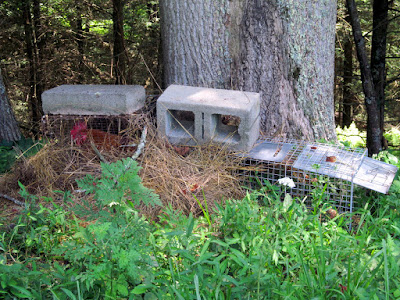a tale of two roosters . . . and a fox
We have had chickens forever and they get occasional infusions of blood from the game hens down the road (no better mothers or laying hens, but small, *very* shy, sometimes mean which means good mothers/bad roosters) or 25 of some dual purpose breed from Southern States. They are a little of everything -- games, rocks, new hampshires, orpingtons and large helpings of aracauna.
An aside: A local college's mascot is the buffalo. They have billboards that say "Be a Buff". I inevitably and always wonder why anyone would want to BE a Buff Orpinton.
Anyone who has ever had any sort of intact male animal knows they can sometimes be trouble from the testosterone. Which is why to not have too many (generally that would be ANY) intact males who are not specifically and actively used for breeding. We had a goat once who decided I smelled good, to the point that I had to carry a 2X4 with me outside. We shortly ate him. Years ago, after we were in this house but before this blog, a rooster decided he didn't like the buttons on one of the girls' snow boots and attacked them (and thus her) repeatedly. We ate him.
So one day we went out and one of our roosters was bloodied. (We had a lot of roosters, I don't know how many. They sort of divided up their territory and got along peaceably. One who stayed close to the house even had a name, Uno, because he was a single hatchling.) We are not without predators so we thought the bloodied one had valiantly attempted to protect the flock because mostly that's what roosters do -- sacrifice themselves. He died. The next day (this is how fast this was), I saw another one bloodied before I left for the barn and woke up a daughter as I didn't know it wasn't Uno who was bloodied, and I didn't know that a dog hadn't done it, and would she watch and figure it out.
It wasn't Uno, and it wasn't the dog.
It was another rooster who had gotten testosterone poisoning. And even though we caught on relatively quickly and he was quarantined by that afternoon, there was only one other rooster left. The rooster with too much testosterone had decided that every other rooster was his enemy and had dispatched them that quickly.
The lone left rooster had survived because he was just that low in the pecking order. We had never even noticed him. I don't know where he hung out before but it wasn't at the house. His toes had gotten frozen at some point in the winter and he has two stubs on one leg and a peg leg for the other. So now he has a name: Pegleg, or Peg. He manages to roost, on the roosts, in the coop at night so he should be good for the next winter. He manages to impress and mount hens. He is, as far as he is concerned, not the least bit disabled. Hooray for that attitude. I mean, it cannot be easy to be a chicken without any toes. How in the world does he manage to roost, much less hold on to the slick back of a hen while, ahem. Yeah. So. People who feel sorry for themselves should learn from him. "Excuses are utterly irrelevant." (Janus Uranus)
And then the fox showed up. Taking one hen at a time, every few days. He has to be dispatched. If we could just shoot him we would but that is a tricky thing mostly on the timing. He's in and gone. Perhaps we could find his den. Someone better at tracking, and better at foxes, likely could. I think we are really supposed to have a trap one size bigger than we do. We trap mostly racoons out of the garden, but the occasional ground hog or possum too.
Trapping the fox could be a challenge. But he or she is hooked on the easy chicken. And we haven't dispatched the delinquent, testosterone poisoned chicken yet. So live bate. Oh, the rooster is safe in the same cage he was in otherwise, and in the shade, and fed and watered daily. But he is camouflaged and hidden, except for through the trap.
So hopefully this works. We trap and kill the fox. We finally eat the rooster. More (nice) roosters rise up from this year's hatchlings.
Peg becomes a legend.
 |
| Peg crowing |


No comments:
Post a Comment